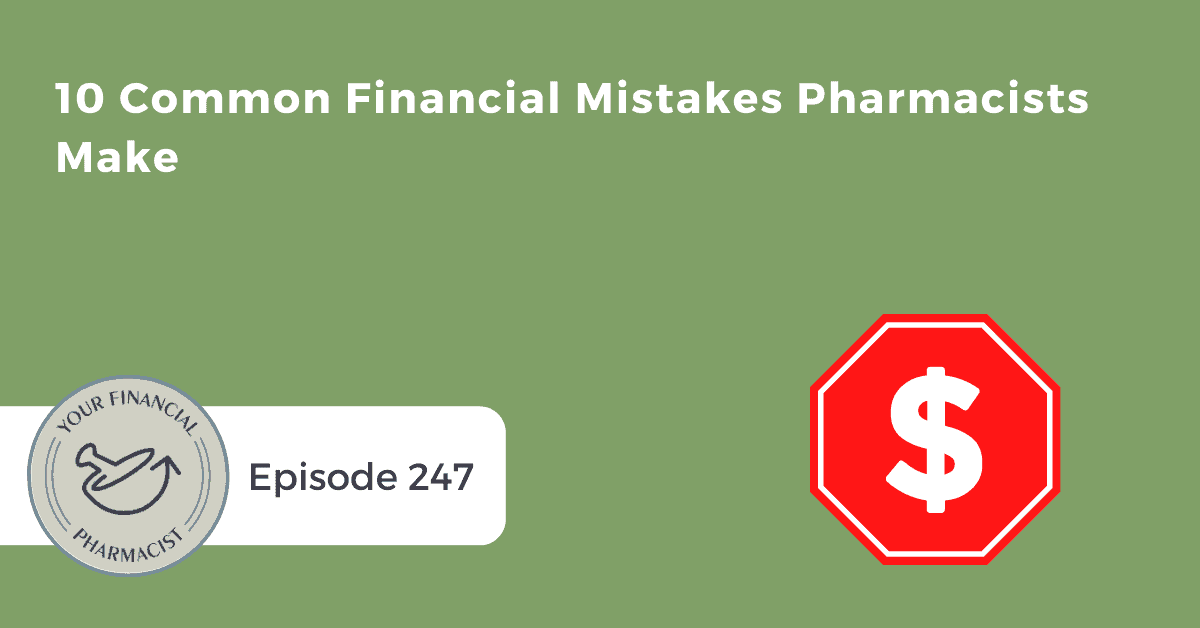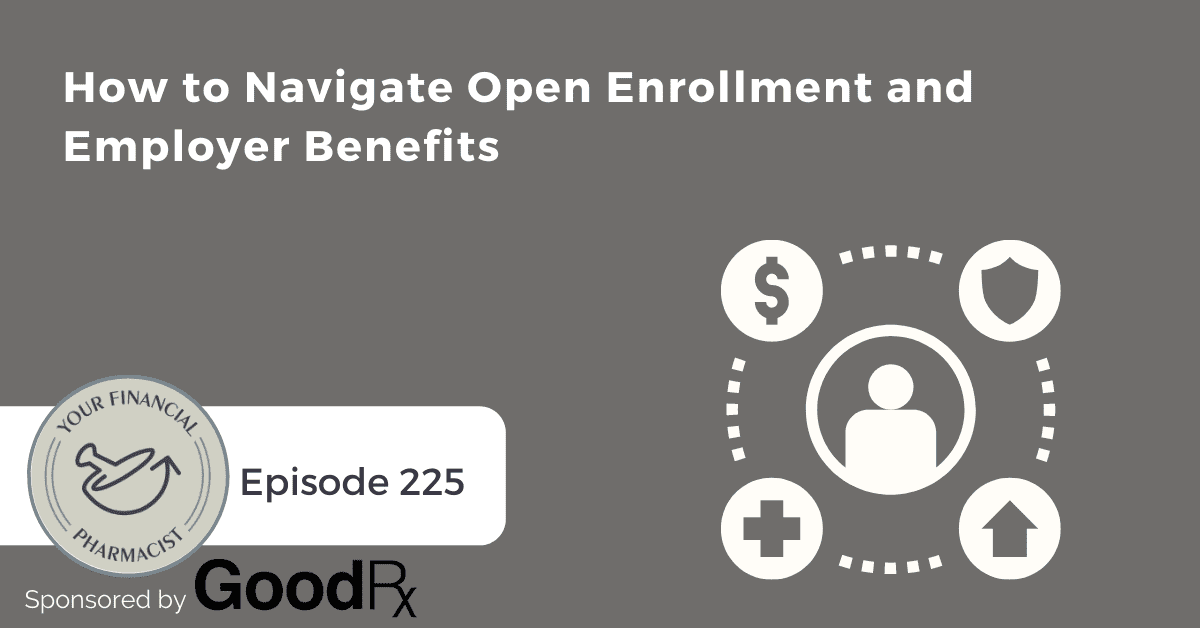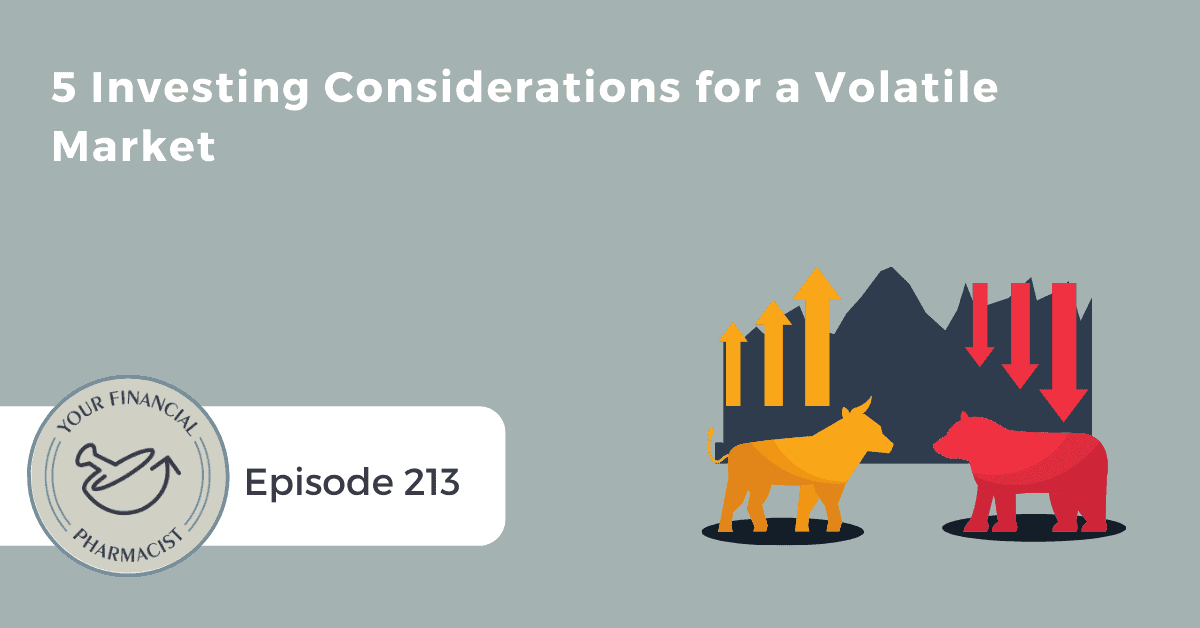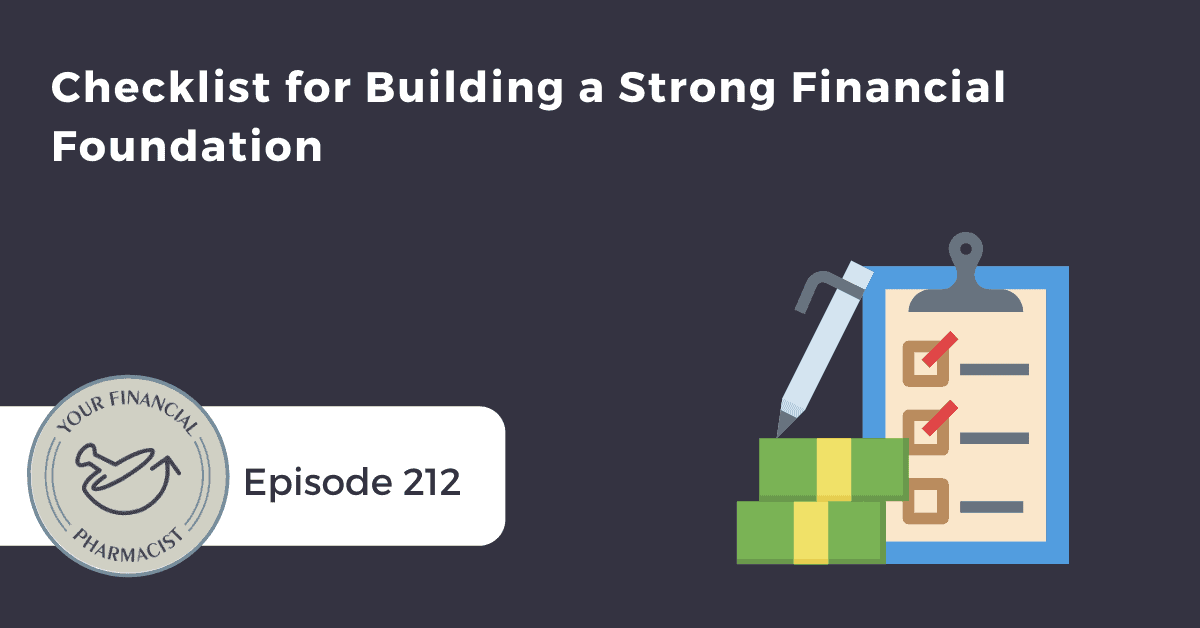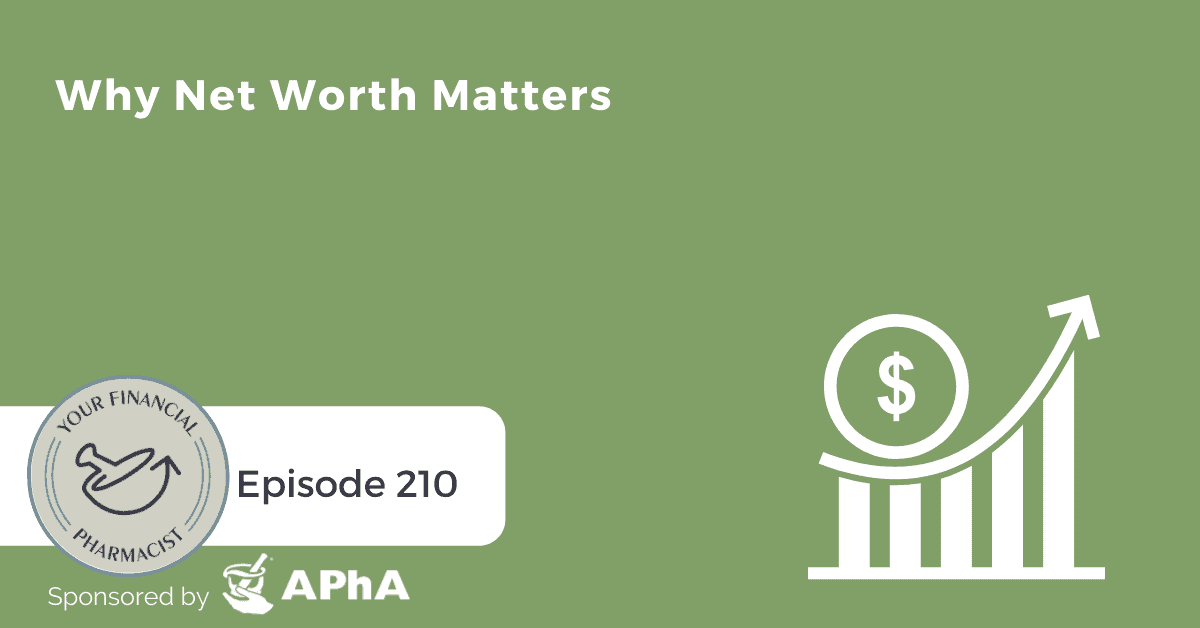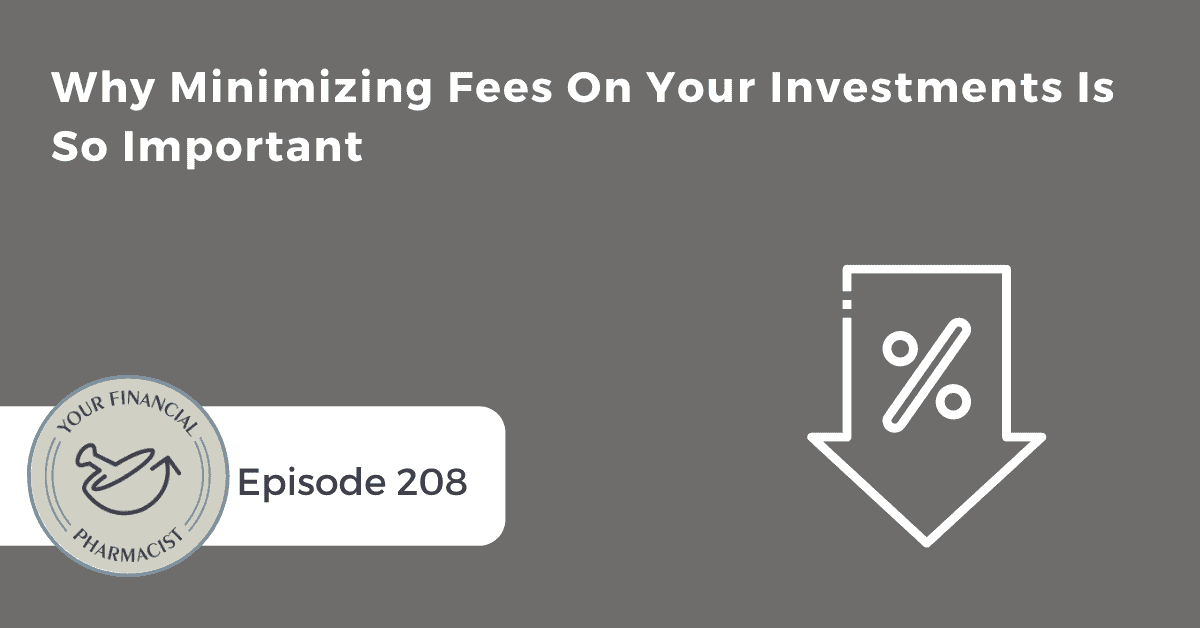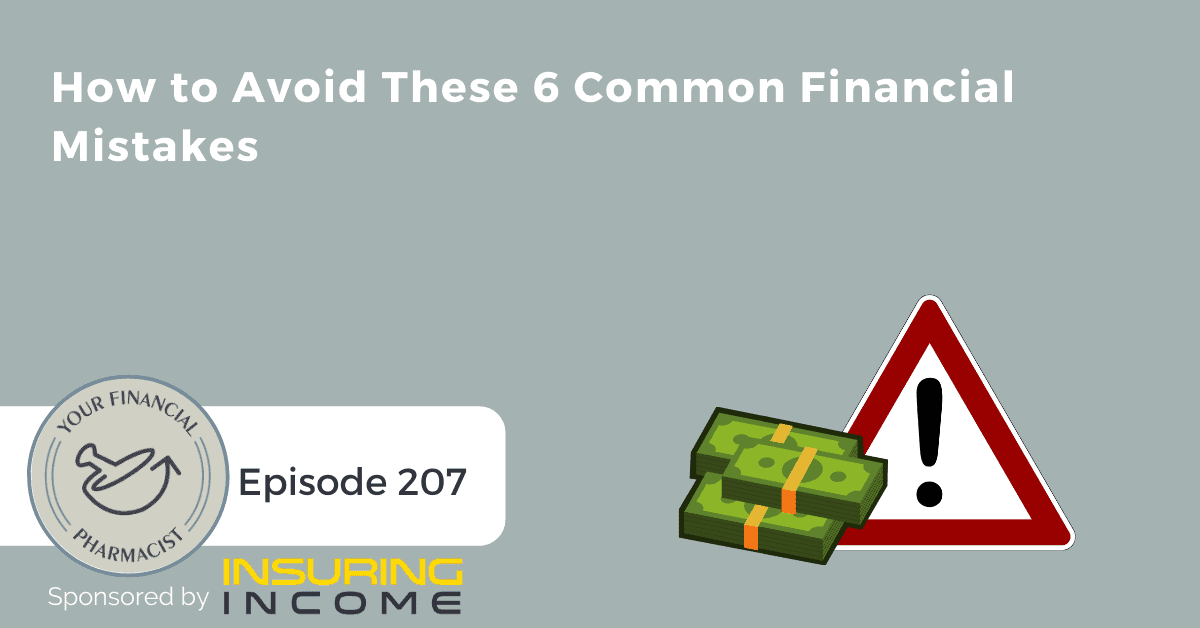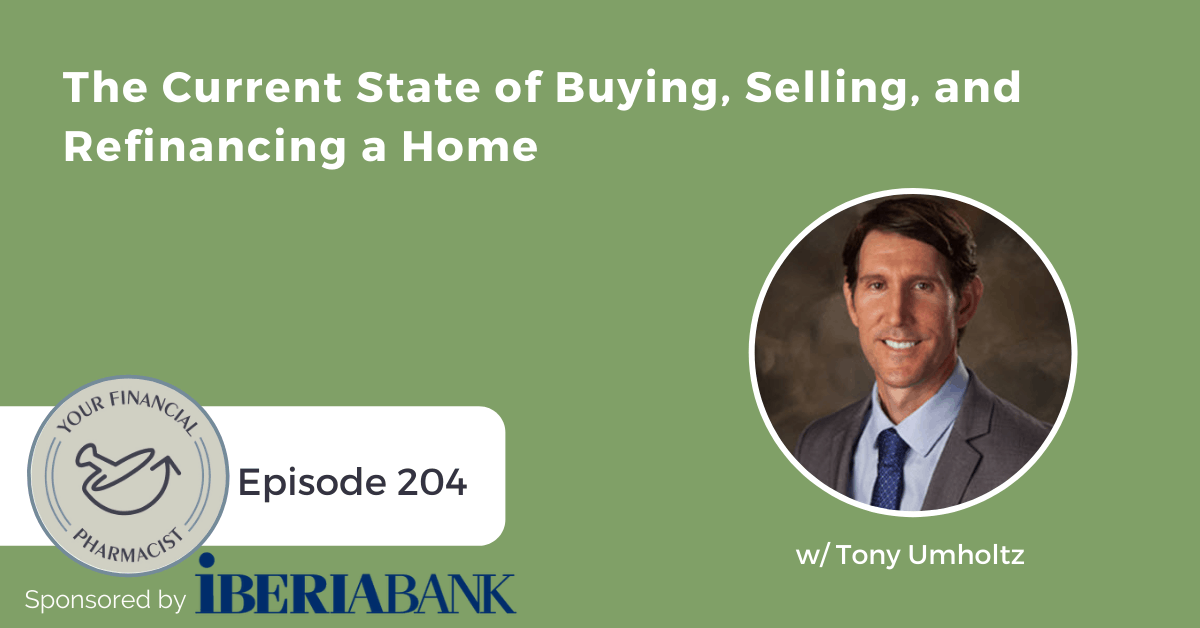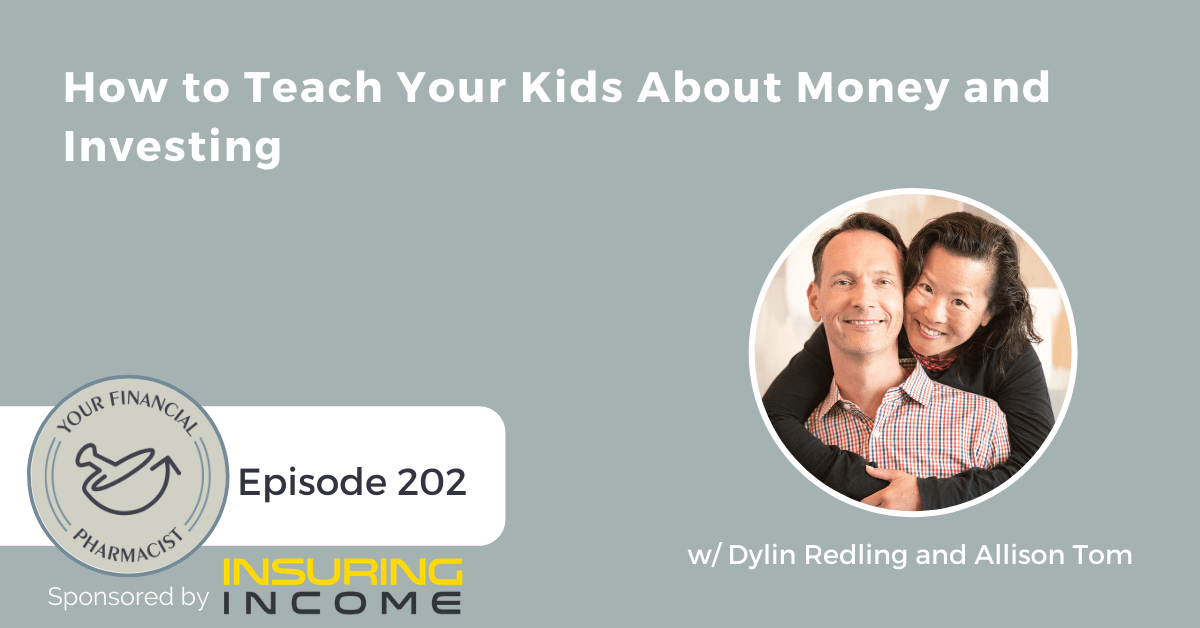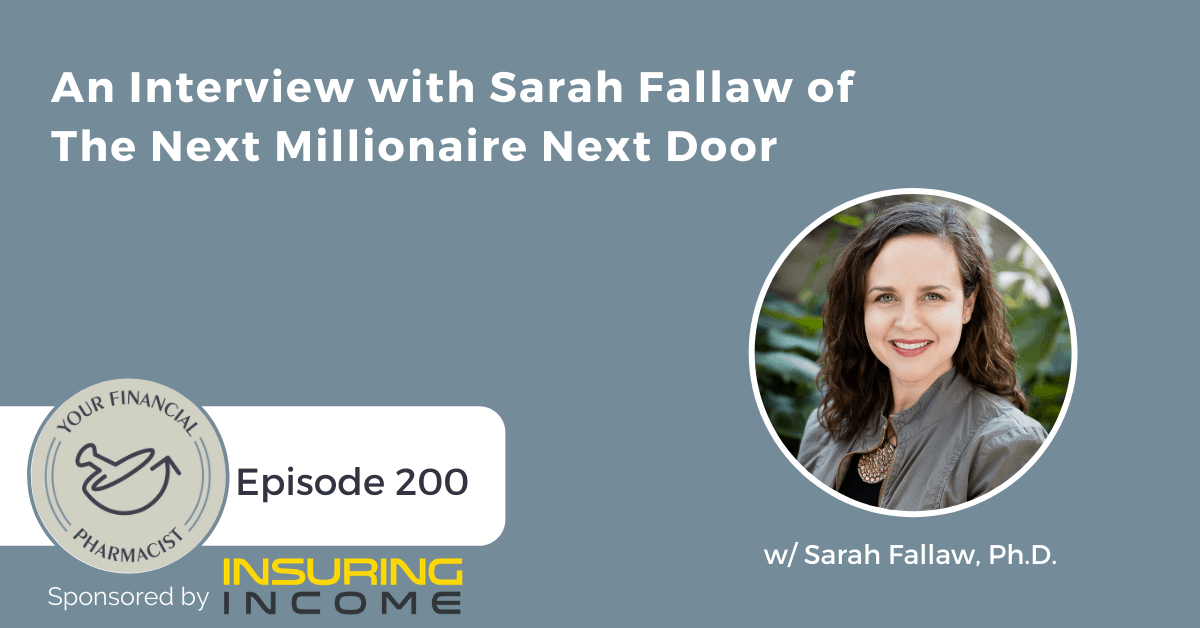10 Common Financial Mistakes Pharmacists Make
On this episode, sponsored by APhA, YFP Co-Founder & CEO, Tim Ulbrich, PharmD, talks about ten common financial mistakes pharmacists make.
Episode Summary
In this episode, Your Financial Pharmacist Co-Founder & CEO, Tim Ulbrich, PharmD, flies solo to dive into ten common financial mistakes that pharmacists make. Tim talks through the math behind the age-old retirement advice that we have all heard, “save early and save often.” He discusses some common mis-prioritization of investments that leave tax savings on the table, like prioritizing non-tax favored investment accounts. Tim further discusses two common student loan mistakes that can cost folks tens of thousands of dollars and in some cases, much more than that; paying too much interest and not maximizing PSLF. Tim shares about the importance of having an emergency fund, protecting your income, and saving for your kid’s college in the correct order. He details common financial missteps such as accepting that income is fixed (because it will change) and failing to or delaying retirement savings, plus some long-term impacts of each. Tim then wraps up with another look at tax planning and how proper tax planning each year (not just tax filing) can affect the financial plan. Lastly, Tim explains how having a financial planner that does not have your best interest in mind can be one of the biggest mistakes that you don’t have to make.
Key Points From This Episode
- The number one mistake on our list: paying too much interest on your student loan debt.
- Tim shares the way to shift your mindset away from the ‘monopoly money’ feeling.
- Diving into student loan strategy and the different buckets to consider.
- Talking about service loan forgiveness and PSLF strategy, and how to maximize these.
- Why emergency funds take a back seat and how to avoid delaying getting one.
- Some tips on starting your emergency fund.
- Mistake number four: protecting your income.
- Accepting your income is fixed, and factoring in inflation and debt loads.
- Putting numbers to the retirement savings saying of ‘save early, save often.’
- Investing in a way that maximizes your tax savings!
- A reminder of why it’s crucial to create a tax strategy and do your tax planning.
- Talking about saving out of order for kid’s college.
- How to get a certified financial planner who has your best interests at heart.
Highlights
“We tend to underestimate how much interest we’re going to pay over the life of a loan and therefore, we tend to underestimate how much we’re going to actually pay out of pocket.” — Tim Ulbrich, PharmD [0:08:37]
“When it comes to insurance, the balance point here is we want to not be underinsured, we want to make sure we can protect the time but we also don’t want to be over-insured.” — Tim Ulbrich, PharmD [0:19:23]
“You can borrow for your kid’s college, but you can’t borrow for your retirement.” — Tim Ulbrich, PharmD [0:30:48]
Links Mentioned in Today’s Episode
- YFP Planning: Financial Planning for Pharmacists
- Schedule a free Discovery Call with YFP Planning
- Join APhA – Get 25% Off Your Membership with Code: YFP
- The Ultimate Guide to Pay Back Pharmacy School Loans
- Learn More About Our 1:1 Student Loan Analysis with a CFP®
- Insurance for Pharmacists
- 19 Ways to Make Extra Money as a Pharmacist in 2020
- YFP 072: Investing Mind Tricks: How Behavioral Bias Affects Our Decisions
- YFP 073: How to Determine the Priority of Investing
- YFP 074: Evaluating Your 401k Plan
- YFP 075: DIY, Robo or Hire a Planner?
- YFP Tax
- YFP 233: Tax Moves to Consider Before 2022
- YFP 211: The Ins and Outs of the 529 College Savings Plan
- YFP 015: Financial Planning Series: Interview w/ Tim Baker (West Point to CFP)
- YFP 016: Financial Planning Series: Benefits of a Financial Planner
- YFP 017: Financial Planning Series: Questions to Ask Your Financial Planner
- Your Financial Pharmacist Disclaimer and Disclosures
Episode Transcript
[INTRODUCTION]
[0:00:00.4] TU: Hey everybody, Tim Ulbrich here and thank you for listening to The YFP Podcast, where each week, we strive to inspire and encourage you on your path towards achieving financial freedom.
This week, I fly solo to talk about 10 common financial mistakes that pharmacists make, no judgment as I’ve made many of these mistakes myself. Some of the highlights from today’s show includes talking through two common student loan mistakes that can cost folks tens of thousands of dollars and in some cases, much more than that, the math behind the age-old advice that we’ve all heard, save early and save often, as well as talking through some common mis-prioritization of investment that leaves tax savings on the table
Now, before we hear from today’s sponsor and then jump into the show, I recognize that many listeners may not be aware of what the team at YFP planning does in working one-on-one with more than 240 households in 40 plus states. YFP planning offers free only, high-touch financial planning that is customized for the pharmacy professional. If you’re interested in learning more about working one-on-one with a certified financial planner may help you achieve your financial goals, you can book a free discovery call at yfpplanning.com.
Whether or not YFP Planning’s financial planning services are a good fit for you, know that we appreciate your support of this podcast and our mission to help pharmacists achieve financial freedom. Okay, let’s hear from today’s sponsor, and then we’ll jump into the show.
[SPONSOR MESSAGE]
Today’s episode of Your Financial Pharmacist Podcast is brought to you by the American Pharmacist Association. APhA is partnered with Your Financial Pharmacist to deliver personalized financial education benefits for APhA members. Throughout the year, APhA will be hosting a number of exclusive webinars covering topics like student loan debt payoff strategies, home buying, investing, insurance needs, and much more.
Join APhA now to gain premier access to these educational resources and to receive discounts on YFP products and services. You can join APhA at a 25% discount by visiting pharmacist.com/join and using the coupon code, YFP. Again, that’s pharmacist.com/join and using the coupon code YFP.
[INTERVIEW]
[0:02:08.5] TU: Hey everybody, Tim Ulbrich here, welcome to this week’s episode of the Your Financial Pharmacist Podcast. I’m flying solo this week and we’re going to talk through 10 common financial mistakes that I see pharmacists often making, that we see pharmacists in the YFP community often making. As I mentioned in the introduction, there is no judgment here in these mistakes.
I’ve made many of these mistakes myself. My hope with this episode, through sharing some of those experiences and other common mistakes that we see folks making, is to hopefully prevent those, right? For others that are perhaps on this journey towards achieving financial freedom.
Before we jump into the 10 common mistakes that we’re going to talk about in today’s episode, I am not going to be covering a few things that are worth noting because I’m going to assume that you’ve got these bases already covered, right? Those would be things like having a budget and being intentional with your spending, so important, right?
We’ve ultimately got a certain amount of income to work with each month, we’ve got a lot of things that are competing for our attention financially, various goals, various expenses and so that budget is going to allow us to be intentional with our spending. I’m going to assume that that is already in place.
I’m also going to assume that we’ve either eliminated any high-interest rate, credit card debt that is revolving each month in a current interest or we’re going to avoid that if we possibly can, right? Very important is, we look at how the impact of that interest can really hurt us as we look at trying to achieve other goals.
Finally, of course, we need to minimize our lifestyle creep, right? For many pharmacists, we know that we see, certainly, a great income overall but that income often can be relatively flat throughout one’s career. Expenses tend to creep up on us over time, perhaps families grow, home expenses, other types of things throughout one’s career and so, we got to do our best to keep those expenses at bay and so that we can focus those limited dollars that we have on other goals each and every month.
Again, things I’m not going to cover, having that budget, being intentional, spending, avoiding, eliminating credit card debt, minimizing lifestyle creep. Now, what we are going to talk about are some common student loan mistakes, we’re going to get really tactical with some numbers that highlight why these mistakes can really have a significant negative impact and really ultimately leave a lot on the table that could be put elsewhere in the plan.
We’ll talk a little bit of our emergency funds and protecting the income. We’ll talk about a couple of things in the long-term savings, retirement side, in terms of prioritization and delaying of savings. Then I’ll wrap up by talking about tax planning as well as looking for a planner that has your best interest in mind.
All right, I hope you’re ready, I’m going to go quick, we’re going to hit a lot of information and we’re going to reference several resources throughout the show and we’ll of course, link to those who you could deep it to those deeper after the recording.
[0:04:49.0] Number one mistake on our list is paying too much interest when it comes to paying off our student loans. Now, you’ve heard me say a hundred times on this show, that pharmacists are facing significant student loan debt. The cost of 2021 to be exact, median debt load, have $170,000 as reported by the American Association Colleges of Pharmacy Graduating Student Survey.
Now, the good news is for the first time in over a decade, we’ve seen that number come down was $175,000 for the class of 2020. Bad news is, that’s still $170,000 and when we look at how interest accrues on a $170,000, those start to be really big numbers. One of the things I often say is that for me in my journey of paying off debt, when I was in school and even early on in the repayment journey, to be frank, it felt a little bit like monopoly money, right?
Once we get into active repayment, once we see the impact of that interest accruing, it starts to become really real, really quick. One of the ways I like to shift that mindset away from that feeling of monopoly money is to calculate the daily interest that is accruing on our loans. The way you do that is take your loan balance that currently remains, you multiply it by your interest rate and you divide it by 365 days.
If you were to have $170,000, let’s just say the Median debt load, $170,000 if we multiply that by 6% and assume that’s an average interest rate across our federal loans, and we divide them by 365, we’re looking at about $28 per day of interest that is accruing. $28 per day. Now, of course, as that $170,000 gets paid down to 160, 150, 140, et cetera or, and/or, we’re able to reduce that interest rate either through our process of refinancing or perhaps some forgiveness opportunity.
Then of course we’re going to see that impact of interest go down but that really is the opportunity cost that we need to be thinking about. $28 per day, if we look at the median debt load of a pharmacy graduate that is going towards interest alone as they begin that repayment period.
[0:06:47.8] One of the feelings I had early on in my repayment journey is I felt like I was spinning my wheels in terms of making substantial monthly payments but not feeling like I was really making a whole lot of progress and momentum towards getting that debt load paid off.
The reason that was and the reason that is for many of you that might be listening to this show, is because the amount of that payment that goes toward interest, right? When we look at big debt loads like 170, 180, $200,000 or perhaps even more at interest rates, six, seven percent, maybe higher on some private loans, what we see is pretty big monthly payments but we also see a lot of that that is going directly towards the interest.
Let me give you an example. If somebody has $170,000, again, let’s just use a 6% average interest rate, if we assume they’re going to pay that off over a 10 year period, that would be the standard repayment option, 120 fixed monthly payments, what we see is a monthly payment of about $1,900 per month for 120 payments or 10 years. $1,900, fixed payment for 10 years.
Now, of that $1,900 that first payment, about $1,000, 45% or so is going to go towards principal and about $850 is going to go towards interest. Right out of the gates, we see that in a standard 10-year repayment about half is going to put a dent in the actual principle and about half is going to go towards interest. And of course, with each monthly payment that we make, we’re going to see a little bit more going toward principle and a little bit less going towards interest.
[0:08:19.2] This is why folks often feel like, “Hey Tim, I’m making big monthly payments but I don’t feel like I’m progressing as quickly as I would like to in terms of getting this paid off” and that’s because of the interest that is accruing on those payments.
One of the common mistakes here that we’re talking about in terms of paying too much interest is we tend to underestimate how much interest we’re going to pay over the life of a loan and therefore, we tend to underestimate how much we’re going to actually pay out of pocket.
I see this all the time and talk with the pharmacy students, they may say, “Hey, I’m borrowing $20,000 a semester” let’s say for tuition cost, the living expenses, they multiply it by eight semesters and they think, “Hey, that’s roughly my student loan debt number.”
Now, what they’re forgetting is of course the interest that’s accruing while they’re in school, outside of administrative forbearance period, such that we’re in right now, and they’re also not including the interest that’s going to accrue while they’re in active repayment, right?
If we’re looking at a 10 year, perhaps for some it’s even a little bit longer repayment journey, then we’re going to see a significant amount of interest that’s also accruing throughout the life of a loan.
That’s why often, folks look up and say, “Wow, that’s a lot more that’s getting paid back than I really had anticipated was going to initially be the case.” What we want to be thinking about here as we talk about this first common mistake, paying too much interest is, what can we be doing to minimize the interest that we’re paying?
[0:09:38.9] That’s where we really get into student loan repayment strategy, right? A topic we have covered, lots of different ways on this show and there’s several different buckets that we need to consider.
That could be tuition reimbursement programs, forgiveness programs, either public service or nonpublic service loan forgiveness programs or we’re going to pay them off but we have an option perhaps to move our loans into the private sector through a refinance that’s going to help us reduce that interest.
The first couple of areas that come to mind if I’m thinking about, “Hey, how can I avoid paying too much interest?” is number one, could I have somebody else pay the bill, right? That could either be through a tuition reimbursement program or through forgiveness, whether that’s PSLF offer or non-PSLF, if that’s not viable or of interest, then perhaps, might I be able to reduce my interest rate through a process of refinancing.
One of the things that we want to avoid is staying in a status quo position in terms of staying in the federal system, paying a high-interest rate, or paying a high private rate, if there’s a better option out there, whether that be forgiveness or whether that be considering a refinance.
A couple of things to think about as we talk about that first mistake of paying too much interest and I’m going to reference a resource here where you can dig more into student loan repayment strategies to evaluate that further.
[0:10:50.9] Number two mistake on our list of 10 is not maximizing public service loan forgiveness. Now, we have talked about this on the show extensively but I feel the need to continue to shout from the mountain top about this topic because there’s a lot of folks that maybe have the option or pursue public service loan forgiveness and for whatever reason aren’t making that choice or folks that are kind of half in and they’re half out, right?
We’re leaving something on the table. When it comes to public service loan forgiveness, assuming that’s the right play for you and your personal financial situation, if we go that pathway, the goal is optimize and maximize forgiveness and minimize what’s out of pocket, right?
When I say, the common mistake here is not maximizing PSLF, what I’m referring to is that we’re leaving something on the table, either we’re paying more interest that we could have forgiven, or/and potentially, we’re not optimizing certain situations that would allow us to be able to also save through our forgiveness period.
One of the things we need to do here is actually break down the numbers of what this means for your personal situation. Now, I’m not going to go through the rules of PSLF, again, we’ve talked about that extensively on the show before, highlights here, we have to work for the right type of employer so 501(c)(3), not for profit or federal government agency or organization.
You have to be in the right kind of loan, so a direct loan, we’ve had some provisions with the Biden administration that have allowed some forgiveness and latitude on that, we’re going to talk about that more in an upcoming show. You have to be in the right repayment plan, which is an income-driven repayment plan.
[0:12:22.8] You have to make 120 payments and be consecutive but 120 qualifying payments before you’re ultimately applying for and receive tax-free forgiveness. Now, one of the things folks often omit, when they’re thinking about optimizing PSLF is really trying to figure out what can I be doing to pay less towards my student loans so that more is forgiven and that really gets to how the monthly payment is calculated towards your student loans when you’re in PSLF through an income-driven repayment plan.
The formula that is used is they take an amount that’s called your discretionary income and that is included of your adjusted gross income, so your taxable income reported on your tax returns, so your AGI, minus 150% of the property level, that is your discretionary income and then that gets multiplied by a certain percentage.
Just by definition of that calculation, there’s some things that we can do if we look at that discretionary income. That AGI minus that 150% poverty level, hopefully, you’re asking yourself, “What could I be doing to lower my AGI?” right? We don’t want to make less money but, “What I could be doing in terms of optimizing strategies to lower my AGI so that I can pay less towards my student loans, increase the amount that’s forgiven, and perhaps also, move forward other financial goals at the same time?”
What we know, what you know from listening to the show is there are strategies that we could do to lower our AGI, right? We think about accounts like 401(k) contributions, 403(b) contributions, HSA contributions. This is where we get to the strategy and the numbers start to become pretty wild in terms of not only optimizing what is forgiven tax-free but also, what could we be putting towards investments that over this repayment period of 10 years with PSLF, we also take advantage of compound interest and compound growth over that period of time.
[0:14:16.0] You know, it doesn’t take a whole lot of whole numbers in terms of putting money away at three, five, seven percent of compounded growth each year. Again, it’s not just the tax-free forgiveness that of course is a huge benefit but also, what can we be doing to moving forward in accelerating our investment plan. That’s the second mistake, not optimizing our PSLF strategy.
Now, a couple of resources I want to point you to here. Student loan repayment, you’ve heard me say it many times, one of the most important decisions pharmacists are going to make early in their career, one that we don’t want to walk into blindly, one that we don’t want to replicate what somebody else is doing that may not be a good fit for our situation.
This decision can be the difference, easily of tens of thousands of dollars, if not more, based on the option you choose and so, I really want you to invest the time and the energy to understanding this loan repayment options, as nuanced as they are. We’ve got a great comprehensive resource, The Ultimate Guide to Pay Back Pharmacy School Loans. It’s a free blog, comprehensive, almost like an ebook, to be honest, you can download that, read that blog at yourfinancialpharmacist.com/ultimate and we’ll link to that in the show notes.
Now, for those of you that are saying, “Hey, the information is great but I want one-on-one help with an expert that knows this in and out.” We do have a one-on-one student loan analysis survey that pairs you up with a YFP Planning certified financial planner and the goal of that is to analyze all of your options and ultimately decide on the best repayment plan for your situation.
You can learn more about that service at yourfinancialpharmacist.com/sla. Again, yourfinancialpharmacist.com/sla. All right, that’s number two, not maximizing PSLF.
[0:15:57.3] Number three is delaying the emergency fund. Now, we just came off of talking about student loan repayment, right? That’s a gorilla that is often in the room. Many folks are also trying to think about saving and investing for the future, perhaps there’s a home purchase, kids that might be involved, kid’s college, the expenses, and the list of expenses goes on and on.
Sometimes, the emergency fund can take a back seat for a couple of reasons. Number one, it’s not very exciting, when you think about making progress on our debt, to become ultimately debt-free whether that’s by paying them off or forgiveness or saving for investing for the future.
Those are typically a little bit more exciting goals to be thinking about. Putting money away in a savings account that’s going to earn minimal but not too exciting amount of interest and it’s there if we need it but hopefully, you don’t, not super exciting, right?
This often may fall by the wayside but the purpose and the goal of that emergency fund is to protect the financial plan when, not if, but when an emergency happens, and work from a position of financial strength with the rest of the plan, right?
[0:16:57.2] This could be a short-term job loss, gap of employment, this could be a health emergency, an emergency with the home, the list of things that could be involved here obviously go on and speaking from personal situations, something will come up at some point, probably not too distant in the futures that is going to require you to tap into this emergency fund.
Generally speaking, our target here is three to six months’ worth of essential expenses. Not to say three to six months’ worth of income but three to six months’ worth of our essential expense because there can be a place where we have too much in this emergency fund. Obviously, we want to be comfortable with that amount but too much means opportunity cost of dollars that could be used elsewhere in the plan.
Now, in terms of where to put it, generally speaking, we’re going to be looking at a long-term savings account, a money market account, somewhere that we can get to the money, it’s a liquid, it’s accessible, it’s running a little bit of interest more than you’re going to see in a checking account, typically which is closer to zero.
Maybe you’re going to getting 0.4, 0.5, 0.6 right now, not too exciting, we’re getting a little bit of interest but it’s a liquid, it’s accessible, this is not the place we’re trying to take a risk with our financial plan, right? We’re going to do that in the savings and investing for the future.
[0:18:05.9] Now, one of the tips that I could share with folks is I think it’s incredibly helpful to get these dollars out of your checking account, right? This really gets to the intentionality of the financial planning.
If we have a bunch of money lumped into our checking account that is for our month-to-month expenses and then we say, “Yeah, I’ve got some of that, that’s earmarked also for an emergency fund,” get it out of the checking account, put it in a separate savings account. Number one, out of sight, out of mind.
Number two, we’re really going to call that account an emergency fund and that’s going to show us our intentionality towards building that and protecting it and getting that out of our month-to-month checking account where we’re either doing our expenses or that we have tied to a credit card where those expenses are charged, so that’s number three.
[0:18:44.0]: Number four is not protecting your income and this obviously gets to a whole laundry list of types of insurance we need to be thinking about including health, home, auto, renters, and so forth, professional liability.
The two that I just wanted to touch on briefly here are term life and long-term disability, and one of the things I often share with pharmacists is “Hey if you are going to do the hard work to really figure out how we’re going to manage just a $170,000 student loan debt if you are going to do the hard work to build a nest egg and a retirement portfolio, we’ve also got to invest some time to make sure we’re playing defense so we are preventing the catastrophic from disrupting that progress in our financial plan. “
When it comes to insurance, the balance point here is we want to not be underinsured, right? We want to make sure we can protect the time but we also don’t want to be over-insured, which is something we often see folks might be in a position of a policy that has been sold to them that is not necessarily coverage that they need or that is in their best interest.
When we are talking about term life insurance what we are talking about here is insurance that would be able to replace your income and what that income provides in the event that you were unexpectedly passed away, right? We’re big advocates of term life insurance. Other types of life insurance out there are whole life, permanent, value types of policies not to say that those don’t have a place anywhere but for the vast majority of folks that we talk with, a coverage with a term life insurance policy might be a 20 or 30-year term.
A million, two million dollars, it really depends on your personal situation but that is going to allow for an affordable monthly payment that is a fixed monthly payment that is going to then allow us to free up dollars to be able to put towards other parts of the financial plan.
[0:20:24.9] In terms of a term life insurance by definition, let’s say somebody buys a 30-year term policy for a million dollars and they’re 30 years old, they are going to pay a monthly or annual premium, depending on how the policy is set that is a fixed monthly payment over that policy length, so it will be a 30-year policy in this case. From 30 to 60 years old in that situation, they would pay a monthly or annual premium.
Now, if they were to die unexpectedly at some point, so let’s say at the age of 50 that person passes away, well at that point their beneficiary would receive the money that’s known as the death benefit and that would be a tax-free policy that would be paid out to the beneficiary. Now, if they don’t die in that 30 year period, which is a good thing that’s the goal, a term life insurance policy, you’re paying those premiums on but you are not going to get those dollars back, right?
If we get to 60, we’ve made it, we are still alive at that point, the policy ends and we are not going to recoup any of those dollars. We are really preventing things on the catastrophic side. We are not looking at this as an investment vehicle. Now, on the disability side, what we are talking about here is really trying to address a scenario where what if you are unable to work as a pharmacist because of a disability?
Car accident, chronic illness, whatever it may be, and obviously at that point, you are disabled and so you are unable to work, in that case, your expenses still live on but your income now here is in jeopardy. A long-term disability policy is the one that we’re often referring to here, again, monthly or annual premium, typically a percentage of your salary that you are going to purchase a policy for.
It could be a five-year, 10-year, 20-year policy up to the age of 65 so it depends on the type of policy, lots of nuances here to think about and then if you were to become disabled, there is going to be known what’s an elimination period, which is the time period between when the disability happens and when your policy kicks in and you have to self-fund that period. It might be 30 to 180 days depending on the policy and then after that point, your monthly policy kicks in to help replace your income.
[0:22:16.8] This is one of the areas we see pharmacists often overlooking and both with term and long-term disability, you may have some base coverage that is provided by your employer. It works a little bit different on the tax side of things of how that benefit is taxed or not taxed depending on where the policy lies and how the premiums are paid and really the question here is, what additional coverage might we need beyond what we have offered through our employer?
If you go to yourfinancialpharmacist.com/insurance, we’ve got two additional resources pages on term life and long-term disability where you can learn more about those and see where that fits in with your financial plan. So that is number four, not protecting your income.
[0:22:57.1] Number five is accepting that your income is fixed. Now, many pharmacists graduated in 2008. If you look at the average of pharmacists in 2008 versus what it is here in 2022, if you factor in inflation, not a whole lot has changed, right? Pharmacists tend to make a great income coming out of the gates but depending on the area of practice that they are in, that income may be relatively flat throughout their career.
All the while our expenses are going up and we also see debt loads continue to creep up through that time period. One of the things we want to be thinking about here is how can we potentially maximize our income, right? This would be a benefit to both diversify your income, so I talk with many pharmacists that might let’s say, full-time at a community pharmacy pick up some PRN hours at a hospital pharmacy so they have their foot in the door at a couple of locations.
Again, additional income but also to diversify, pharmacists that are working on side hustles and doing some medical writing or other businesses to generate additional revenue, also areas of interest. And so this could help us diversify but also can help us accelerate our financial goals, so lots to think about here and this really is very much an individualized decision and we’ve got a great resource available, 14 Extra Ways That Pharmacists Can Consider Making Additional Income. That is a blog that we have in the YFP blog, we’ll link to that in the show notes with this episode.
[0:24:19.5] Number six is delaying retirement savings. Now, many of us have been told by parents, grandparents, perhaps multiple people that you need to be saving as early and often as you can, right? Time value of money, compound interest, as Albert Einstein said, it is the eighth wonder of the world and so what we’ve been told, what we’ve been taught is the longer we delay our savings, the harder it is going to be to catch up.
I want to put some numbers to this because I think sometimes we hear that, were like, “Yeah, yeah, easier said than done. You don’t have $170,000 in student loan debt, you aren’t trying to purchase a home and doing all of these other financial goals at the same time” but the math here is really compelling.
If we look at a pharmacist who is making about the average salary of a pharmacist that’s out there if we assume they are putting away about 15% of their income and they are getting an average annual rate of return on their portfolio around 6%. So if you look at the historical rate of return of the stock market around 10% net of inflation closer to 7% and so if they are putting away 15% of their income and they have a desired retirement age of 60, what we see is by putting away about 15% of their income each and every year, if they start at the age of 25, when they get to the age of 60, they’re going to have about 2.6 million dollars saved.
Now, if they wait to the age of 30, that 2.6 turns into about 1.8. If they wait to the age of 35, that 2.6 that could have been if we started at 25 turns into 1.2 and if we wait to the age of 40, that 2.6 turns into $800,000. So that value, that advice is real, right? The earlier we invest and save, obviously we are going to have more time for that money to grow and to do its thing in terms of compound interest throughout many, many years.
Again, we’re just talking about one factor here in a vacuum as we talk about delaying retirement savings. We of course have to zoom out and consider this with other financial goals that we’re working on but ultimately, as we are able to do. We want to be focusing on starting as early as we possibly can.
[0:26:17.9] Number seven here is prioritizing non-tax favored investment accounts. Now, we talked in episodes 72 through 75, we did a series on kind of an investing 101 series meant to be a crash course for those that are wanting to learn more about investing in terminology, some of the biases associated with investing, some of the information on fees, types of accounts, 401(k)s, IRAs, et cetera and so that is a great primer if you want to go back and listen to episode 72 through 75.
What I am referring to here is investing potentially out of order. Now, this is certainly not investment advice, right? We don’t know anything about your personal situation but there is some low-hanging fruit from a tax advantage investing standpoint, right? When you think about 401(k), 403(b), employer-sponsored retirement accounts especially when we think about employer match, free money, right? We have all been told that before.
If we keep working down there, we think about things like health savings accounts, triple tax benefits. We have talked about that on the show before, Roth IRA accounts. Again, another account where we might be putting dollars in that have already been taxed but they’re going to grow tax-free, we pull them out without a future tax burden, so if we are contributing to let’s say a brokerage account, whether it is through a tool like Robin Hood or Acorns or Betterment or whatever be the app or tool. But we are not yet taking advantage of some of those other things, the question we want to ask ourselves is, are we investing in a way that’s going to allow us to maximize our tax savings, right?
Are we investing in appropriate priority? There certainly is I think a place and a role for a brokerage or taxable account but let’s be thinking about the order in which we are doing that relative to employer retirement accounts, IRAs, HSAs, and so forth.
[0:28:02.1] Number eight here is tax filing without tax planning and strategy. Now, we’ve been hitting on this in the show in the last three to six months, shout out to the team at YFP Taxes doing a great job servicing the clients of YFP planning as well as some new clients here in 2022 and what I am referring to here is someone who is doing tax preparation but is not thinking more strategically on the tax planning side.
So, if we look at a pharmacist on average, if they are making an average income working 40 years or so, and if we adjust up that salary for inflation of pharmacists throughout their career as going to earn about $9 million in their career. But only about six million of that depending on their tax situation is going to hit their bank account, so that delta of $3 million is what we want to be thinking about to pay our fair share, right? But we want to optimize how we can be able to use dollars elsewhere if we can allocate those towards a financial plan.
Tax preparation, that’s what we are all doing, we’re required to do it, right? If we don’t file our taxes by April 15, the IRS is going to be coming knocking on our door unless we file for an extension. Tax preparation is historical. It is looking backward, so it limits the impact that we can truly have on our tax liability because things have been done at that point in time, so it is mechanical, we have to file, it’s looking back.
Where tax planning is more of the forward-focus strategic part of integrating the tax plan with the financial plan. Here is where we can avoid common issues in advance, right? We can look at how we can adjust withholdings, do some projections, how can we optimize our savings accounts, how might we look at our savings and philanthropic contributions to be able to optimize those as well.
Lots of things to consider, there’s optimization strategies around long term savings accounts HSAs, 529s, we know there is tax saving strategies with PSLF, lots of child-related optimization strategies, child care credits, dependent care FSAs, maximizing charitable contributions, you know really the list goes on, right? If we are able to do more of that planning and strategy work and look ahead, then we’re obviously able to take advantage of those, so that when we do the filing, we know we have optimized the situation throughout the year.
I would reference folks to episode 233, where our director of tax, Paul Eikenberg and I talked about some tax moves to consider from an optimization standpoint and we’ll link to that in the show notes.
[0:30:27.2] Number nine here is saving for kids college out of order. Guilty as charged, right? I found myself in this trap and as I reflect on that, I think about, “Well, why was that the case?” right? I knew about tax advantage, retirement vehicles, I knew that I have been given the advice over and over again that you can borrow for college, you can borrow for your kid’s college, but you can’t borrow for your retirement, so why was I not focused on the correct order of that?
The more I thought about that, was that it was my reaction to my own journey of not wanting to see my kids incur a couple hundred thousand dollars of student loan debt, right? I think for many pharmacists, that may be the same thing where they are going through their own journey, they are living through that, obviously, the pain of it may be right in front of them right now. And therefore, they might be looking at saving in a 529 account with good intentions, but are we doing that in the right order, right?
This is a great example of where we don’t want to look at one part of the financial plan and the silo because if we just answer the question, saving for kid’s college in a 529, is that a good financial move? Sure, there is tax benefits in doing that especially if we look at the potential growth over 10, 15, or 20 years. If we zoom out and look at what else we’re doing to financial plan that may or may not be the move to make at that time.
We talked on episode 211, the ins and outs of the 529 college savings plans and we’ll link to that in the show notes for more information.
[0:31:51.5] Finally number 10, hiring a planner that does not have your best interest in mind. Now full disclaimer of the bias of the planning services that are offered by YFP Planning, we wholeheartedly believe in fee-only financial planning and we’ll talk about that here in the moment. Obviously, I have a bias towards the services that the team at YFP planning offers, so we need to keep that in mind as we talk about this tenth point.
Now, we talked on episodes 15, 16, and 17 way back when we did a three-part series on working with a planner, what to look for, questions to ask and we also talked about why fee-only financial planning matters. When you think about working with a financial planner here, is the term financial planner or adviser in it itself does not necessarily mean something that we can hang our hat on, right?
We, in the pharmacy world, we’re used to the PharmD board certifications and residencies. We know exactly what those credentials mean and there is a relative amount of consistency in those credentials, so that when someone says, “I completed a PGY-1 residency.” We know what that means.
When it comes to financial planning, financial advisors, wealth managers, wealth advisers, there are a wide variety in terms of education, training, and experience. And what those services look like that will inform and help inform whether or not those may be a good fit for you. So we need to be looking at, what is the educational background of these individuals, what is the credential, how are these individuals regulated?
We firmly believe in the certified financial planner credential, we’ve got five CFPs on the YFP planning team. The CFP is certainly not a credential that is required to do financial planning but very robust in terms of the requirements of the educational portion of the CFP or rigorous examination to pass as well as an experiential component that we would think of as like appys in terms of pharmacy education.
[0:33:42.7] Other things to consider here, I have mentioned the term fee-only, so fee-only by definition is that you are paying the planner and the planning team for the advice that they are giving, so they are not getting paid by recommending products such as insurance or investments where they’d be on a commission, and obviously a potential bias on that recommendation. And then we also really encourage folks to look at whether we are or are not the solution that is the best fit, someone who really offers comprehensive financial planning.
The reason that’s important is that historically, the industry has focused a lot on investments and insurance, you know, think of folks that might be a little bit further along in their career, they have a substantial amount of assets to manage. And so, often there may be a minimum of assets to work with a firm, but when it comes to other things that might be of significance like student loan debt, like some of the early insurance discussions.
Like, “Hey, I am thinking about starting a business or a side hustle” or “I’m looking at purchasing a home or investing in real estate” or “What about the estate plan?” or “What about the tax part of the financial plan?” Making sure the adviser regardless of the stage that you are in of your career, making sure the adviser and the advising team has the expertise and the experience to be able to serve you and the needs that you have for your financial plan.
When it comes to working with YFP Planning, we’re really proud of the work that the planning team does. I mentioned five CFPs, shoutout to our lead planners, Robert Lopez and Kelly Reddy-Heffner who lead those two teams, working with Robert is Kim CFP and Savannah, working with Kelly is Christina, CFP, and Sarah. And then we also have a tax team that supports the financial planning.
We are currently working with about 250 households and over 40 states all across the country, very robust in terms of the comprehensive nature of the plan. For folks that are interested in learning more about that service and what it would look like in terms of working one-on-one with a YFP certified financial planner, you can visit, yfpplanning.com, and you can book a free discovery call with Justin Woods, also a pharmacist who is our director of business development.
[0:35:40.8] Well, that’s 10 common financial mistakes that we see pharmacists making. I really appreciate you joining me on this week’s episode and we’ll see you here again next week.
[END OF DISCUSSION]
[0:35:48.4] TU: Before we wrap up today’s episode of Your Financial Pharmacist Podcast, I want to again thank our sponsor, The American Pharmacist Association. APHA is every pharmacist’s ally advocating on your behalf for better working conditions, fair PBM practices and more opportunities for pharmacists to provide care.
Make sure to join a bolder APHA to gain premier access to financial educational resources and to receive discounts on YFP products and services. You can join APHA at a 25% discount by visiting pharmacist.com/join and using the coupon code, “YFP”. Again, that’s pharmacist.com/join and using the coupon code “YFP”.
[DISCLAIMER]
[0:36:28.5] TU: As we conclude this week’s podcast, an important reminder that the content on this show is provided to you for informational purposes only and it is not intended to provide and should not be relied on for investment or any other advice. Information of the podcast and corresponding materials should not be construed as a solicitation or offer to buy or sell any investment or related financial products. We urge listeners to consult with a financial advisor with respect to any investment.
Furthermore, the information contained in our archived newsletters, blog post and podcast is not updated and may not be accurate at the time you listen to it on the podcast. Opinions and analysis expressed herein are solely those of your financial pharmacist unless otherwise noted and constitute judgments as of the dates published. Such information may contain forward looking statements, which are not intended to be guarantees of future events. Actual results could differ materially from those anticipated in the forward looking statements. For more information, please visit yourfinancialpharmacist.com/disclaimer.
Thank you again for your support of the Your Financial Pharmacist Podcast. Have a great rest of your week.
[END]
Current Student Loan Refinance Offers
[wptb id="15454" not found ]Recent Posts
[pt_view id=”f651872qnv”]

